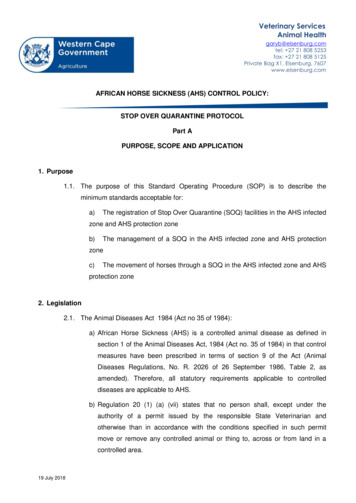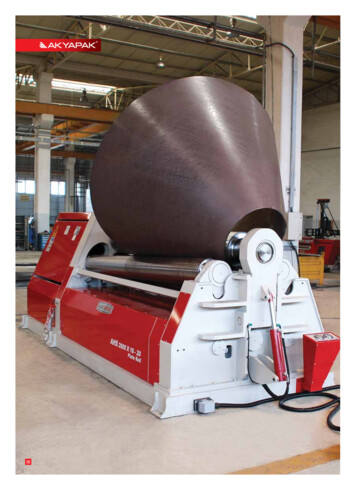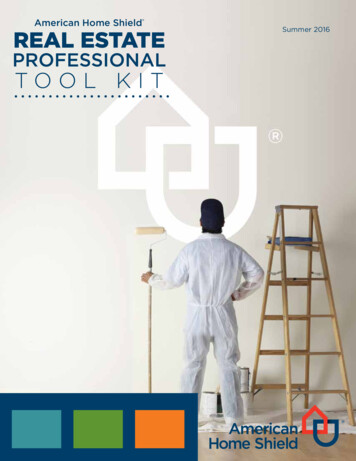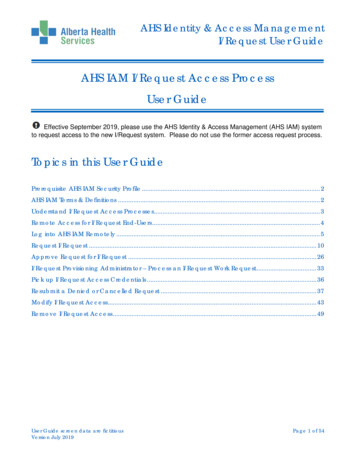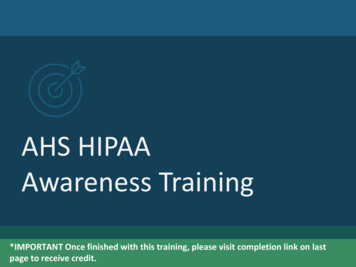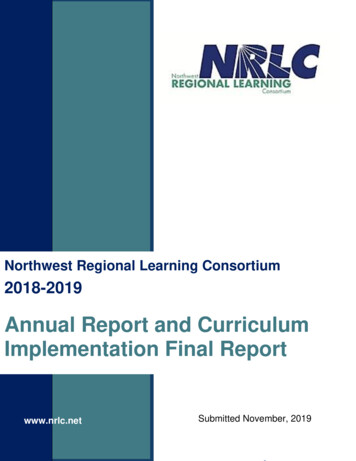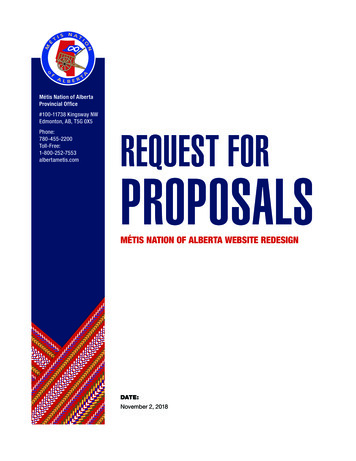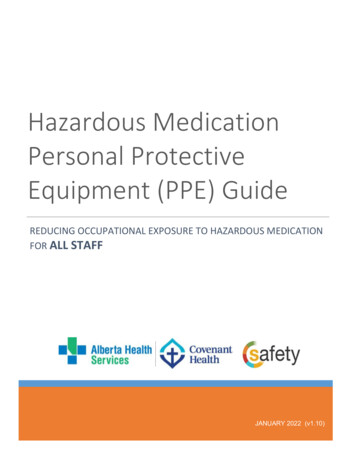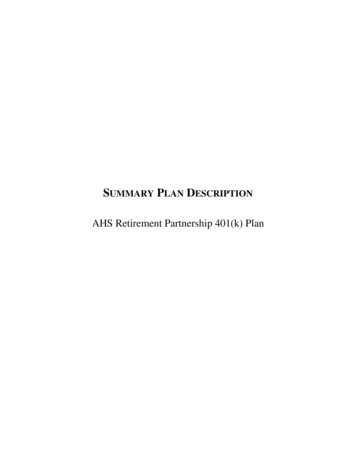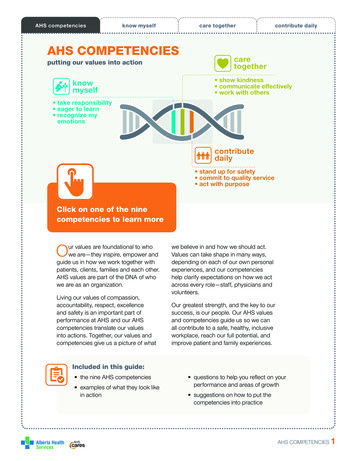
Transcription
AHS competenciesknow myselfcare togetherAHS COMPETENCIESputting our values into actionknowmyselfcontribute dailycaretogether show kindness communicate effectively work with others take responsibility eager to learn recognize myemotionscontributedaily stand up for safety commit to quality service act with purposeClick on one of the ninecompetencies to learn moreOur values are foundational to whowe are—they inspire, empower andguide us in how we work together withpatients, clients, families and each other.AHS values are part of the DNA of whowe are as an organization.Living our values of compassion,accountability, respect, excellenceand safety is an important part ofperformance at AHS and our AHScompetencies translate our valuesinto actions. Together, our values andcompetencies give us a picture of whatwe believe in and how we should act.Values can take shape in many ways,depending on each of our own personalexperiences, and our competencieshelp clarify expectations on how we actacross every role—staff, physicians andvolunteers.Our greatest strength, and the key to oursuccess, is our people. Our AHS valuesand competencies guide us so we canall contribute to a safe, healthy, inclusiveworkplace, reach our full potential, andimprove patient and family experiences.Included in this guide: the nine AHS competencies examples of what they look likein action questions to help you reflect on yourperformance and areas of growth suggestions on how to put thecompetencies into practiceAHS COMPETENCIES1
know myselfAHS competenciescare togethercontribute dailyWHY ARE THEY IMPORTANT?Our people, patients and families have made it clear thatit’s not just about what we do, but also how we do it.Our behaviours affect how we work together, the careand services we provide, and our relationships withothers.AHS competencies are sets of behaviours that clarifyexpectations for performance across every role. Theyguide us by showing how we can act in three areas:knowing ourselves, caring together and contributingdaily. There are three competencies under each areawith three behaviours that describe the competency inaction.Whether we’re applying for a job with AHS, are newto the organization, or have been here for years, AHScompetencies will be part of everything we do.In addition to AHS competencies, here are someexamples of other competencies used within AHS: LEADS in a Caring Environment is the frameworkused to develop and strengthen leadership abilities.professional leadershipcompetencies competenciesCompetencies strengthen our ability toprovide quality care and services talking about growth and developmentAHS competencies work hand-in-hand with otherprofessional, occupational and leadership competenciesthat are needed to meet our job requirements. Theserequirements may vary depending on where we areand what we do. AHS competencies help to defineexpectations that are common to all of us.occupationalcompetenciesAHS competencies empower each of us to own ourperformance as we reflect, seek feedback and createplans for growth and development.Identifying the behaviours that contribute to successfulperformance gives us a common language and sharedunderstanding of what is expected when we providecare and services. Use our AHS competencies when:Competencies clarify expectationsVary bywhat we do Professional and occupational competencies are theknowledge, skills and abilities needed to performyour job duties. Professional Practice in Action isanother tool that helps AHS healthcare professionalscreate quality outcomes and positive patient andfamily experiences.Commonto all of us recognizing success seeking or giving feedback looking for ways to enhance team culture making hiring decisionsAlongside our values, AHS competencies will be acommon thread in the processes for how we hire,develop and recognize our people. This includesquestions we ask in interviews, what we look for incandidates, the learning programs we design, how wecoach people, and how we celebrate their successes.VISIONMISSIONVALUESAHScompetenciesCODEOF CONDUCTVary by whoand where we arelocation backgroundexperienceAHS COMPETENCIES2
AHS competenciesknow myselfcare togethercontribute dailyAHS ow we reflect and lookfor opportunities to growhow we treat others andwork togetherhow we make a differenceand achieve our goalstake responsibilityshow kindnessstand up for safety own my decisionsand actions consider and respond toothers’ needs follow safety protocolsand standards follow through onmy commitments understand and respectothers’ differences be alert for hazards andspeak up acknowledge and tryto fix my mistakes be friendly, helpful and caring share safety knowledgewith otherseager to learncommunicateeffectively own my growthand development seek and use feedbackfor self-improvement learn from my experiences recognize myemotions provide timely, complete andappropriate informationstrive to understandclients’ needs adapt to meet others’ needsand to be understoodfocus on what mattersto clients look for ways to improveour serviceswork with othersnotice how my emotionsaffect others stay calm and respectfulin difficult situations focus on finding solutionsseek others’ opinionsand perspectivescommit to qualityservicebuild positive relationshipswork together to getthings doneencourage andappreciate othersact with purpose make decisions in atimely manner embrace new ideas andways of working move forward and adjustas neededAHS COMPETENCIES3
AHS competenciesknow myselfcare togethercontribute daily“I am by no means perfect andthat’s OK. I often slip up but Ialways try to watch my words, limitassumptions, let things go and domy best and I believe I am happierbecause of it.”Steen PedersenEMS Quality & Patient Safety Directortake responsibilitybehaviours own my decisionsand actions follow through onmy commitments acknowledgeand try to fix mymistakesWhat it can look likeWhat it doesn’t look likeI take responsibilityfor the things I do.Denying that I didsomething.I do what I say andkeep my promises.Making excuses whenI haven’t completed awork assignment.I own up to my partwhen things go wrong.Blaming others whenthings go wrong.How am I doing?When have Iacknowledged mydecisions and actions?What holds me back?Would others describeme as dependable? Whyor why not?When I made a mistake,how did I respond? DidI own up to it and try tofix it?How I can growPutting this into practice Think about how I takeresponsibility for my own actions.What helps or hinders me? Participate in regular conversationswith your leader and co-workers aboutyour performance. Ask for feedback fromco-workers and my supervisoron how dependable I am. Discuss and report in the Reporting& Learning System all care-relatedadverse events and close calls. Access learning to enhance mypersonal accountability. Use respectful workplace resources tohelp you address a workplace issue orconflict with a co-worker.AHS COMPETENCIES4
AHS competenciescare togetherknow myselfcontribute daily“Two of our NICU nurses presentededucation on skin-to-skin care to theirObstetrics colleagues. The team reallyjumped on board and have becomeextremely strong advocates for skin-toskin care for our moms and babies. It’snow a standard of practice at our site.”Candice EdeyExecutive Associateeager to learnbehaviours own my owngrowth anddevelopment seek and usefeedback forself-improvement learn from myexperiencesWhat it can look likeWhat it doesn’t look likeI keep up to date withleading/best practices.Not making timefor developmentactivities.I ask others abouthow I am doing incommunicatingeffectively.Becoming defensivewhen given feedback.I think about my workand look at whatwent well and howto improve.Making the samemistakes overand over.How am I doing?What have I donerecently to growand develop?How have I consideredothers’ feedback so thatI can grow?How do I use myexperiences asopportunities to learn?How I can growPutting this into practice Think about ways I can growand develop. Use multi-source feedback toolsand informal conversations to helpseek feedback. Seek feedback on my strengthsand where I can improve. Explore opportunities, and/orstretch assignments withmy leader. Develop a learning/development planand review it regularly. Learn about Knowledge ResourceServices to find resources on evidenceinformed decision-making and qualitypatient care.AHS COMPETENCIES5
AHS competenciesknow myselfcare togethercontribute daily“We’re good at putting on a uniform anddisguising how we feel. If we sit at thatrevved-up state and don’t give ourselvestime to come down, our stress responseis really affected. Having time to de-stressallows us to calm down the system—andtap into an area where we can make goodjudgment calls once we’re back on the job.”Molly VargaAHS peer support workerrecognize my emotionsbehavioursWhat it can look likeWhat it doesn’t look like notice how myemotions affectothersI can describe how Iam feeling.Allowing my emotionsto negatively impactmy actions. stay calm andrespectful indifficult situationsI use positive “self-talk”in difficult situations.Reacting in a waythat makes a difficultsituation even worse. focus on findingsolutionsI consider multipleoptions whenproblem solving.Assuming thatthere is always aright and wrong.How am I doing?Am I aware of how Icome across to others?What helps me staycomposed? What causesme to lose composure?How do I work towardfinding solutions?How do I support my coworkers to do the same?How I can growPutting this into practice Take the time for quiet reflectionto consider how my emotions andbehaviours help or hinder me. Take advantage of the AHS resourcesthat support health and wellness. Identify what causes me to havea strong reaction. Learn more about emotionalintelligence in the workplace. Use the Change the Conversation:Developing Self-Awareness resourceto help you understand how youractions impact others. Debrief with everyone involvedfollowing emotionally charged events.AHS COMPETENCIES6
know myselfAHS competenciescare togethercontribute daily“It’s connections. It’s hearing Blackfootspoken. It’s learning about traditionalpractice or historical things weask participants to check in and wemeasure their happiness, anxiety andenergy. Overwhelmingly people leavefeeling happier.”Heidi DavisAHS Recreation Therapistshow kindnessbehavioursWhat it can look likeWhat it doesn’t look likeHow am I doing? consider andrespond toothers’ needsI take the time to offerhelp to others.Assuming you knowwhat is best forsomeone.How do I show thatI am attentive toothers’ needs? understandand respectfor others’differencesI show interest inlearning more aboutmy co-workers.Criticizing or judgingothers’ behaviour.What beliefs do I haveabout others who aredifferent from me? be friendly,helpful and caringI greet patientsand families in ourfacilities and assistwith way-finding.Responding toa request in animpatient, abrupttone.How do I contributeto a caring atmosphereat work?How I can growPutting this into practice Start noticing the kind acts of others.Look at what they do and how theyconsider others’ needs. Ask co-workers, patients/clients andfamilies what matters to them. Notice how often I take the time to thinkabout another person’s perception beforeI make a judgement. Be willing to examine my biases,including events or people that triggercertain feelings and how they influencemy behaviour. Check out Change the Conversation andDiversity & Inclusion resources on Insiteto learn how to recognize our differences. Offer welcoming words and a smile.AHS COMPETENCIES7
know myselfAHS competenciescare togethercontribute daily“I followed up on a rental unit that had anextreme bug and cockroach infestation.I contacted the language line and aninterpreter spoke Oromo with the tenantand English to me.”Darrell ProkopishinPublic Health Inspectorcommunicate effectivelybehavioursWhat it can look like seek others’opinions andperspectives What it doesn’t look likeHow am I doing?I listen and askquestions tounderstand what theother person is saying.Interrupting others orstopping them fromfully explaining.Do I try to understandothers before putting myideas forward? How canI do better?provide timely,complete andappropriateinformationI take the time to verifyinformation is correctbefore sharing.Being late or notgiving regularupdates.How do I ensure Icommunicate in atimely manner?adapt to meetothers’ needs andbe understoodI provide information ina variety of ways.Using slang,abbreviations orlanguage whichothers may notunderstand.What do I do to makesure others canunderstand me?How I can growPutting this into practice Think about how effective I am in seekingothers’ opinions. Use the Change the Conversationresource on email communicationfor teams to help you send clear andrespectful messages. Ask others how they like to provide andreceive communication. Look for learning opportunities in theareas of communication styles, diversityand inclusion, and patient and familycentered care. Use “NOD” (name, occupation andduty) when you interact with a client. Use “check back/read back” toconfirm understanding.AHS COMPETENCIES8
know myselfAHS competenciescare togethercontribute daily“What I really look for on my teamis compassion and empathy,and the ability to be patient andfamily-centred throughout all thechallenges we face daily.”Jessica BrownProtective Services Site Managerwork with othersbehavioursWhat it can look likeWhat it doesn’t look likeHow am I doing? build positiverelationshipsI try to get toknow the peopleI work with.Participating in,encouraging ortolerating gossip.What can I do to buildbetter relationshipsat work? work together toget things doneI contribute positivelyto the team andsupport others whomight need help.Being overlycompetitive orneeding to be right.What are the things Ido to contribute to ourteam’s work? encourage andappreciate othersI take time to tell othersthey are doing a goodjob.Not seeingvalue in differentperspectives.What is something I doto encourage othersto share their ideas orthoughts?How I can growPutting this into practice Think of someone I consider an effectiveteam member. Notice what they do todevelop good working relations. Send an e-card or note to thanka co-worker. Seek feedback on how I am contributingto the team and what I could do better. Take part in a team conversationabout staff engagement anddiscuss the Our People survey. Learn about communication techniquesthat help everyone feel included. Take time to participate in teambuilding activities.AHS COMPETENCIES9
know myselfAHS competenciescare togethercontribute daily“We really stressed to our peoplethat, at AHS, our priority is fixingthe problem, not pointing fingers.We wanted people to feel safewhen they report an adverse event.”Dr. Verna YiuAHS President and CEOstand up for safetybehavioursWhat it can look likeWhat it doesn’t look likeHow am I doing? follow safetyprotocols andstandardsI am aware of theemergency responsecodes and know howto respond.Feeling that standardsare optional andare only for new orinexperienced staff.What is my level ofawareness of the safetyprotocols and standardsin my area or work? be alert forhazards andspeak upWhen I seesomething thatcould harm others,I act or speak up.Ignoring risks andhazards becauseit feels like it isn’tmy job.What are some of thetools I use to speak upwhen I see a hazardor safety concern thatcould impact thosearound me? share safetyknowledge withothersI take time to talk withclients and co-workersabout risks andconcerns.Assuming everyoneis aware of the risksassociated witha task.How do my actionsreflect the importanceof sharing/reportinghazards or safetyconcerns?How I can growPutting this into practice Notice the high-risk activities in my area. Thenconsider ways to keep myself, my team andclients safe. Offer to present a safety moment at ateam meeting. Have a conversation with a co-worker or leaderabout how to improve situations where safetyprotocols or standards are not being followed. Report worker and client hazards,near misses/close calls and incidentsin MySafetyNet (MSN) or Reporting &Learning System (RLS). Take Workplace Hazardous Materials InformationSystem (WHMIS) education in MyLearningLink. Comply with and advocate for handhygiene best practice.AHS COMPETENCIES10
know myselfAHS competenciescontribute dailycare together“Having a positive impact on oursystem’s ability to deliver the rightservices in the right place at the righttime. Being responsive to feedbackand finding solutions that makethings better for the people we servekeeps me jazzed.”Edith Zuidhof-KnoopAddictions and Mental Health Directorcommit to quality servicebehavioursWhat it can look likeWhat it doesn’t look likeHow am I doing? strive tounderstandclients’ needsI seek informationto understand myclients’ needs.Assuming what isbest for clients andfailing to ask whatmatters to them.What am I doing tounderstand how to bestserve my clients’ needs? focus onwhat mattersto clientsI ask questions andoffer choices toensure I focus on whatmatters to my client.Developing planswithout consideringthe clients goals.What are some of theformal and informalways I find out about theneeds of my clients? look for waysto improveour servicesI share ideas on waysto make servicesbetter or safer withsomeone in leadership.Not being open tochanging the wayit has always beendone.How do I show mycommitment toimproving care/servicesto my clients?How I can growPutting this into practice Reflect upon how often I ask clients whatmatters to them, and how I respond. Ask your leader about how you canparticipate in local improvement initiatives. Have a conversation with my leader onthe ways I can support innovation andquality in my area. Enroll in an Alberta Improvement Way (AIW)workshop to learn more about improvingprocesses and problem solving. Watch a video on the AHS YouTubechannel to hear perspectives frompatients, families and clients. Ask your leader about patient/clientexperience data to inform improvements.AHS COMPETENCIES11
know myselfAHS competenciescare togethercontribute daily“It’s so exciting to be amongthe first to make this change.ConnectCare is going to be a bigchallenge that requires us all towork closely together.”Cathy OsborneSenior Operating Officeract with purposebehavioursWhat it can look likeWhat it doesn’t look likeHow am I doing? make decisions ina timely mannerI am able to balancethe need for moreinformation against theneed to take action.Avoiding makingdecisions.How comfortable am Iin making decisions? DoI jump to decisions tooquickly or do I stall? embrace newideas and waysof workingI actively supportefforts to improveprocesses.Giving up and goingback to the old way ifthe new way presentsan obstacle.How do I respond whena new idea or way ofworking is implementedor suggested? move forward andadjust as neededI participate in changeinitiatives and can beflexible if there arechallenges.Acting impatient orfrustrated duringtimes of uncertaintyor ambiguity.How might I support myteam when they seemto be stuck or unsure ofwhat to do?How I can growPutting this into practice Notice how I feel when an idea forimprovement is suggested and takenotice of how others react. Take action when a client orco-worker may be at risk. Have a conversation with someoneabout a big change that is happeningand discuss how we can supporteach other. Learn more about Connect Careand support this change. Use the change managementbest practice and/or the PROSCImethodologies. Learn more about the AHSimprovement way and otherimprovement practices.AHS COMPETENCIES12
competencies will be part of everything we do. AHS competencies work hand-in-hand with other professional, occupational and leadership competencies that are needed to meet our job requirements. These requirements may vary depending on where we are and what we do. AHS competencies help to define expectations that are common to all of us.
